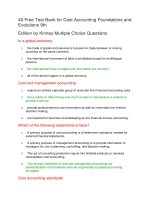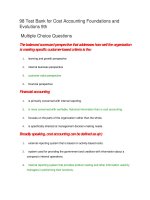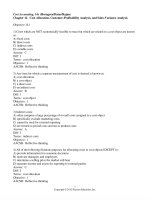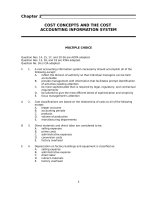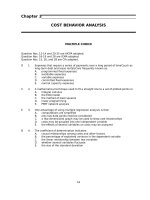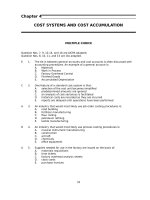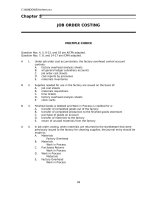Test bank cost accounting foundations and evolutions 8e by raiborn chapter 14
Bạn đang xem bản rút gọn của tài liệu. Xem và tải ngay bản đầy đủ của tài liệu tại đây (288.69 KB, 43 trang )
Chapter 14—Capital Budgeting
LEARNING OBJECTIVES
LO
LO
LO
LO
LO
LO
1
2
3
4
5
6
LO 7
LO 8
LO 9
LO 10
LO 11
Why do most capital budgeting methods focus on cash flows?
How is payback period computed, and what does it measure?
How are the net present value and profitability index of a project measured?
How is the internal rate of return on a project computed? What does it measure?
How do taxation and depreciation methods affect cash flows?
What are the underlying assumptions and limitations of each capital project
evaluation method
How do managers rank investment projects?
How is risk considered in capital budgeting analysis?
How and why should management conduct a postinvestment audit of a capital
project?
(Appendix 1) How are present values calculated?
(Appendix 2) What are the advantages and disadvantages of the accounting rate
of return method?
QUESTION GRID
True/False
Difficulty Level
Easy
1
2
3
4
5
6
7
8
9
10
11
12
13
14
15
16
17
18
19
20
21
22
23
24
25
26
27
28
29
30
Mod
x
x
Diff
x
x
x
x
x
LO
1
x
x
x
x
x
x
LO
2
LO
3
LO
4
Learning Objectives
LO
LO
LO
5
6
7
LO
8
LO
10
LO
11
LO
LO
x
x
x
x
x
x
x
x
x
x
x
x
x
x
x
x
x
x
x
x
x
x
x
x
x
x
x
x
x
x
x
x
x
x
x
x
x
x
x
x
x
x
x
x
x
x
Difficulty Level
Easy
Mod
LO
9
x
Diff
LO
LO
LO
2
LO
Learning Objectives
LO
LO
LO
LO
LO
1
31
32
33
34
35
36
Completion
2
3
4
Easy
X
X
X
X
X
Mod
Diff
LO
1
x
x
x
LO
2
LO
3
LO
4
8
9
10
x
x
x
x
X
X
X
Learning Objectives
LO
LO
LO
5
6
7
LO
8
LO
10
LO
11
x
x
X
X
x
x
x
x
x
x
x
x
X
X
x
x
Mod
Diff
LO
1
LO
2
x
x
x
x
x
x
LO
3
LO
4
Learning Objectives
LO
LO
LO
5
6
7
LO
8
LO
9
LO
10
LO
11
LO
8
LO
9
LO
10
LO
11
x
x
x
x
x
x
x
x
x
x
x
X
X
X
X
X
x
x
x
x
x
x
x
X
X
x
x
x
x
x
x
X
x
X
Easy
X
LO
9
x
x
x
Easy
X
X
X
X
X
X
X
X
X
X
X
X
X
X
X
11
x
x
x
x
Difficulty Level
29
30
7
x
x
x
Difficulty Level
1
2
3
4
5
6
7
8
9
10
11
12
13
14
15
16
17
18
19
20
21
22
23
24
25
26
27
28
6
x
x
x
Difficulty Level
1
2
3
4
5
6
7
8
9
10
11
12
13
14
15
16
17
Multiple Choice
5
X
X
X
Mod
x
Diff
LO
1
LO
2
x
x
LO
3
3
LO
4
Learning Objectives
LO
LO
LO
5
6
7
31
32
33
34
35
36
37
38
39
40
41
42
43
44
45
46
47
48
49
50
51
52
53
54
55
56
57
58
59
60
61
62
63
64
65
66
67
68
69
70
71
72
73
74
75
76
77
78
79
80
81
82
83
84
85
86
87
X
x
x
x
x
x
x
x
x
x
x
X
X
X
X
X
X
x
X
X
X
X
x
x
x
x
x
x
X
X
x
x
x
x
x
x
x
x
x
x
x
x
x
X
X
x
X
X
X
X
X
X
x
x
x
x
X
X
x
x
x
x
x
x
x
x
x
x
x
x
x
x
x
x
x
x
x
x
x
x
x
x
x
x
x
x
x
x
x
x
x
x
x
x
x
x
x
x
Difficulty Level
Easy
88
89
90
91
92
x
x
x
x
Mod
x
x
x
x
x
x
x
x
x
x
x
x
x
x
x
Diff
LO
1
LO
2
LO
3
x
x
X
LO
4
Learning Objectives
LO
LO
LO
5
6
7
LO
8
LO
9
LO
10
x
x
x
x
X
4
LO
11
93
94
95
96
97
98
99
100
101
102
103
104
X
X
X
X
x
x
x
x
x
x
x
x
x
x
x
x
x
x
x
x
X
X
x
x
Short Answer
Difficulty Level
Easy
1
2
3
4
5
6
7
8
9
10
Mod
x
x
x
x
x
x
x
x
x
x
Diff
LO
1
LO
2
LO
3
LO
4
Learning Objectives
LO
LO
LO
5
6
7
LO
8
x
LO
9
LO
10
LO
11
x
x
x
x
x
x
x
x
x
Problem
Difficulty Level
Easy
Mod
Diff
LO
1
LO
2
LO
3
LO
4
1
x
2
x
3
x
4
x
5
x
x
6
x
x
7
x
x
8
x
x
Learning Objectives
LO
LO
LO
5
6
7
LO
8
LO
9
LO
10
x
x
x
x
5
LO
11
TRUE/FALSE
1. Capital budgeting uses financial criteria exclusively when evaluating projects.
ANS: F
DIF: Moderate
OBJ: 14-1
2. Capital budgeting uses both financial and non-financial criteria when evaluating projects.
ANS: T
DIF: Moderate
OBJ: 14-1
3. Most capital budgeting techniques focus on cash flows.
ANS: T
DIF: Easy
OBJ: 14-1
4. Project funding is a financing decision.
ANS: T
DIF: Easy
OBJ: 14-1
5. Project funding is an investing decision.
ANS: F
DIF: Easy
OBJ: 14-1
6. The decision concerning which assets to acquire to achieve an organization’s objectives is an investing
decision.
ANS: T
DIF: Easy
OBJ: 14-1
7. The payback period ignores the time value of money.
ANS: T
DIF: Easy
OBJ: 14-2
8. An organization’s discount rate should be less than the organization’s cost of capital.
ANS: F
DIF: Moderate
OBJ: 14-2
9. An organization’s discount rate should be equal to or exceed the organization’s cost of capital.
ANS: T
DIF: Moderate
OBJ: 14-2
10. If the net present value is positive, the actual return on a project exceeds the required rate of return.
ANS: T
DIF: Easy
OBJ: 14-3
11. The net present value method provides the actual rate of return for a project.
ANS: F
DIF: Moderate
OBJ: 14-3
12. The profitability index gauges the efficiency of a firm’s use of capital.
ANS: T
DIF: Moderate
OBJ: 14-3
6
13. If a project’s internal rate of return is greater than or equal to an organization’s hurdle rate, the project
is considered to be an acceptable investment.
ANS: T
DIF: Moderate
OBJ: 14-4
14. If a project’s internal rate of return is greater than or equal to an organization’s hurdle rate, the project
is considered to be an unacceptable investment.
ANS: F
DIF: Moderate
OBJ: 14-4
15. The internal rate of return is the rate at which a project’s net present value is zero.
ANS: T
DIF: Moderate
OBJ: 14-4
16. An organization’s hurdle rate should be at least equal to the organization’s cost of capital.
ANS: T
DIF: Moderate
OBJ: 14-4
17. Depreciation expense provides a tax shield against the payment of taxes.
ANS: T
DIF: Easy
OBJ: 14-5
18. The tax benefit from depreciation expense is the depreciation amount multiplied by the tax rate.
ANS: T
DIF: Moderate
OBJ: 14-5
19. The tax benefit from depreciation expense is the depreciation amount divided by the tax rate.
ANS: F
DIF: Moderate
OBJ: 14-5
20. Using MACRS depreciation for tax purposes and straight-line depreciation for book purposes will
affect after-tax cash flows during the life of a project.
ANS: T
DIF: Difficult
OBJ: 14-5
21. A decision in which projects are ranked according to their impact on achieving company objectives is a
screening decision.
ANS: F
DIF: Moderate
OBJ: 14-6
22. A decision in which projects are ranked according to their impact on achieving company objectives is a
preference decision.
ANS: T
DIF: Moderate
OBJ: 14-6
23. In a mutually inclusive project situation, if one project is chosen, all related projects are also chosen.
ANS: T
DIF: Moderate
OBJ: 14-6
24. In a mutually inclusive project situation, if one project is chosen, all related projects are eliminated
from further consideration.
ANS: F
DIF: Moderate
OBJ: 14-6
7
25. Managers must often use multiple measures to effectively rank capital projects.
ANS: T
DIF: Easy
OBJ: 14-7
26. Reinvestment assumptions are different under each method of ranking capital projects.
ANS: T
DIF: Moderate
OBJ: 14-7
27. When considering risk, a manager will often use a judgmental method of risk adjustment.
ANS: T
DIF: Easy
OBJ: 14-8
28. When using the risk-adjusted discount rate method, a manager increases the rate used for discounting
future cash inflows.
ANS: T
DIF: Moderate
OBJ: 14-8
29. When using the risk-adjusted discount rate method, a manager increases the rate used for discounting
future cash outflows.
ANS: F
DIF: Moderate
OBJ: 14-8
30. Postinvestment audits can provide feedback of the accuracy of original cash flow estimates.
ANS: T
DIF: Easy
OBJ: 14-9
31. Present value and future value computations assume the use of compound interest.
ANS: T
DIF: Easy
OBJ: 14-10
32. For an ordinary annuity, the first cash flow occurs at the end of the period.
ANS: T
DIF: Easy
OBJ: 14-10
33. For an annuity due, the first cash flow occurs at the end of the period.
ANS: F
DIF: Easy
OBJ: 14-10
34. The accounting rate of return considers the salvage value of an asset.
ANS: T
DIF: Moderate
OBJ: 14-11
35. The accounting rate of return considers the time value of money.
ANS: F
DIF: Moderate
OBJ: 14-11
36. Accounting rate of return is based on cash flows.
ANS: F
DIF: Moderate
OBJ: 14-11
8
COMPLETION
1. The evaluation of future long-range projects to allocate resources effectively and efficiently is referred
to as ______________________________________.
ANS: capital budgeting
DIF: Easy
OBJ: 14-1
2. A judgment regarding an entity’s method of funding an investment is considered to be a(n)
_______________________ decision.
ANS: financing
DIF: Easy
OBJ: 14-1
3. A judgment regarding which assets an entity should acquire to achieve its stated objectives is
considered to be a(n) _______________________ decision.
ANS: investing
DIF: Easy
OBJ: 14-1
4. A capital budgeting method that measures the time required for a project’s cash inflows to equal the
original investment is referred to as the _________________________.
ANS: payback period
DIF: Easy
OBJ: 14-2
5. The rate of return required by a company that is used to determine the imputed interest portion of
future cash receipts and disbursements is referred to as the _______________________.
ANS: discount rate
DIF: Easy
OBJ: 14-2
6. The weighted average cost of an organization’s various sources of funds is referred to as
______________________________.
ANS: cost of capital
DIF: Moderate
OBJ: 14-2
7. A capital budgeting technique that compares a project’s rate of return with the desired rate of return for
an organization is known as the _______________________________ method.
ANS: net present value
DIF: Easy
OBJ: 14-3
9
8. A ratio comparing the present value of a project’s net cash inflows to the project’s net investment is
referred to as the ____________________________________.
ANS: profitability index
DIF: Easy
OBJ: 14-3
9. The discount rate that causes the present value of a project’s net cash inflows to equal the present value
of the cash outflows is referred to as the ________________________________________.
ANS: internal rate of return
DIF: Easy
OBJ: 14-4
10. The rate of return specified as the lowest acceptable return on an investment is referred to as the
________________________________.
ANS: hurdle rate
DIF: Moderate
OBJ: 14-4
11. A decision regarding whether a capital project is desirable based upon some previously established
minimum criteria is referred to as a(n) ___________________________________.
ANS: screening decision
DIF: Easy
OBJ: 14-6
12. A decision in which projects are ranked according to their impact on the achievement of company
objectives is referred to as a(n) ___________________________________.
ANS: preference decision
DIF: Easy
OBJ: 14-6
13. When a project is chosen from a group and all other projects are excluded from further consideration,
the project is referred to as _________________________________.
ANS: mutually exclusive.
DIF: Moderate
OBJ: 14-6
14. In a _________________________________ project situation, if one project is chosen, all related
projects are also chosen.
ANS: mutually inclusive
DIF: Moderate
OBJ: 14-6
15. The process of determining the amount of change that must occur in a variable before a different
decision would be made is referred to as _________________________________.
ANS: sensitivity analysis
10
DIF: Moderate
OBJ: 14-8
16. When information on actual project results is gathered and compared to actual results, the process is
referred to as a(n) ______________________________________.
ANS: postinvestment audit
DIF: Easy
OBJ: 14-9
17. The capital budgeting technique that divides average annual profits from an investment by the average
investment in a project is referred to as the _____________________________________.
ANS: accounting rate of return
DIF: Easy
OBJ: 14-11
MULTIPLE CHOICE
1. Which of the following capital budgeting techniques ignores the time value of money?
a. payback period
b. net present value
c. internal rate of return
d. profitability index
ANS: A
DIF: Easy
OBJ: 14-2
2. Which of the following capital budgeting techniques may potentially ignore part of a project's relevant
cash flows?
a. net present value
b. internal rate of return
c. payback period
d. profitability index
ANS: C
DIF: Easy
OBJ: 14-2
3. In comparing two projects, the ___________ is often used to evaluate the relative riskiness of the
projects.
a. payback period
b. net present value
c. internal rate of return
d. discount rate
ANS: A
DIF: Easy
OBJ: 14-2
4. Which of the following capital budgeting techniques does not routinely rely on the assumption that all
cash flows occur at the end of the period?
a. internal rate of return
b. net present value
c. profitability index
d. payback period
ANS: D
DIF: Easy
OBJ: 14-2
11
5. Assume that a project consists of an initial cash outlay of $100,000 followed by equal annual cash
inflows of $40,000 for 4 years. In the formula X = $100,000/$40,000, X represents the
a. payback period for the project.
b. profitability index of the project.
c. internal rate of return for the project.
d. project's discount rate.
ANS: A
DIF: Easy
OBJ: 14-2
6. All other factors equal, a large number is preferred to a smaller number for all capital project
evaluation measures except
a. net present value.
b. payback period.
c. internal rate of return.
d. profitability index.
ANS: B
DIF: Easy
OBJ: 14-2
7. The payback method assumes that all cash inflows are reinvested to yield a return equal to
a. the discount rate.
b. the hurdle rate.
c. the internal rate of return.
d. zero.
ANS: D
DIF: Easy
OBJ: 14-6
8. The payback method measures
a. how quickly investment dollars may be recovered.
b. the cash flow from an investment.
c. the economic life of an investment.
d. the profitability of an investment.
ANS: A
DIF: Easy
OBJ: 14-6
9. If investment A has a payback period of three years and investment B has a payback period of four
years, then
a. A is more profitable than B.
b. A is less profitable than B.
c. A and B are equally profitable.
d. the relative profitability of A and B cannot be determined from the information given.
ANS: D
DIF: Easy
OBJ: 14-2
10. The payback period is the
a. length of time over which the investment will provide cash inflows.
b. length of time over which the initial investment is recovered.
c. shortest length of time over which an investment may be depreciated.
d. shortest length of time over which the net present value will be positive.
ANS: B
DIF: Easy
OBJ: 14-2
12
11. Which of the following capital budgeting techniques has been criticized because it fails to consider
investment profitability?
a. payback method
b. accounting rate of return
c. net present value method
d. internal rate of return
ANS: A
DIF: Easy
OBJ: 14-6
12. The time value of money is explicitly recognized through the process of
a. interpolating.
b. discounting.
c. annuitizing.
d. budgeting.
ANS: B
DIF: Easy
OBJ: 14-2
13. The time value of money is considered in long-range investment decisions by
a. assuming equal annual cash flow patterns.
b. investing only in short-term projects.
c. assigning greater value to more immediate cash flows.
d. ignoring depreciation and tax implications of the investment.
ANS: C
DIF: Easy
OBJ: 14-3
14. When using one of the discounted cash flow methods to evaluate the desirability of a capital budgeting
project, which of the following factors is generally not important?
a. method of financing the project under consideration
b. timing of cash flows relating to the project
c. impact of the project on income taxes to be paid
d. amounts of cash flows relating to the project
ANS: A
DIF: Easy
OBJ: 14-3
15. With regard to a capital investment, net cash inflow is equal to the
a. cost savings resulting from the investment.
b. sum of all future revenues from the investment.
c. net increase in cash receipts over cash payments.
d. net increase in cash payments over cash receipts.
ANS: C
DIF: Easy
OBJ: 14-1
16. In a discounted cash flow analysis, which of the following would not be consistent with adjusting a
project's cash flows to account for higher-than-normal risk?
a. increasing the expected amount for cash outflows
b. increasing the discounting period for expected cash inflows
c. increasing the discount rate for cash outflows
d. decreasing the amount for expected cash inflows
ANS: C
DIF: Moderate
OBJ: 14-3
13
17. When a project has uneven projected cash inflows over its life, an analyst may be forced to use
_______ to find the project's internal rate of return.
a. a screening decision
b. a trial-and-error approach
c. a post investment audit
d. a time line
ANS: B
DIF: Easy
OBJ: 14-4
18. The interest rate used to find the present value of a future cash flow is the
a. prime rate.
b. discount rate.
c. cutoff rate.
d. internal rate of return.
ANS: B
DIF: Easy
OBJ: 14-2
19. A firm's discount rate is typically based on
a. the interest rates related to the firm's bonds.
b. a project's internal rate of return.
c. its cost of capital.
d. the corporate Aa bond yield.
ANS: C
DIF: Easy
OBJ: 14-2
20. In capital budgeting, a firm's cost of capital is frequently used as the
a. internal rate of return.
b. accounting rate of return.
c. discount rate.
d. profitability index.
ANS: C
DIF: Easy
OBJ: 14-2
21. The net present value method assumes that all cash inflows can be immediately reinvested at the
a. cost of capital.
b. discount rate.
c. internal rate of return.
d. rate on the corporation's short-term debt.
ANS: B
DIF: Easy
OBJ: 14-3
22. Which of the following changes would not decrease the present value of the future depreciation
deductions on a specific depreciable asset?
a. a decrease in the marginal tax rate
b. a decrease in the discount rate
c. a decrease in the rate of depreciation
d. an increase in the life expectancy of the depreciable asset
ANS: B
DIF: Moderate
OBJ: 14-5
14
23. To reflect greater uncertainty (greater risk) about a future cash inflow, an analyst could
a. increase the discount rate for the cash flow.
b. decrease the discounting period for the cash flow.
c. increase the expected value of the future cash flow before it is discounted.
d. extend the acceptable length for the payback period.
ANS: A
DIF: Easy
OBJ: 14-2
24. A change in the discount rate used to evaluate a specific project will affect the project's
a. life.
b. payback period.
c. net present value.
d. total cash flows.
ANS: C
DIF: Easy
OBJ: 14-6
25. For a project such as plant investment, the return that should leave the market price of the firm's stock
unchanged is known as the
a. cost of capital.
b. net present value.
c. payback rate.
d. internal rate of return.
ANS: A
DIF: Moderate
OBJ: 14-5
26. The pre-tax cost of capital is higher than the after-tax cost of capital because
a. interest expense is deductible for tax purposes.
b. principal payments on debt are deductible for tax purposes.
c. the cost of capital is a deductible expense for tax purposes.
d. dividend payments to stockholders are deductible for tax purposes.
ANS: A
DIF: Easy
OBJ: 14-5
27. The basis for measuring the cost of capital derived from bonds and preferred stock, respectively, is the
a. pre-tax rate of interest for bonds and stated annual dividend rate less the expected earnings
per share for preferred stock.
b. pre-tax rate of interest for bonds and stated annual dividend rate for preferred stock.
c. after-tax rate of interest for bonds and stated annual dividend rate less the expected
earnings per share for preferred stock.
d. after-tax rate of interest for bonds and stated annual dividend rate for preferred stock.
ANS: D
DIF: Moderate
OBJ: 14-5
28. The combined weighted average interest rate that a firm incurs on its long-term debt, preferred stock,
and common stock is the
a. cost of capital.
b. discount rate.
c. cutoff rate.
d. internal rate of return.
ANS: A
DIF: Easy
OBJ: 14-2
15
29. The weighted average cost of capital that is used to evaluate a specific project should be based on the
a. mix of capital components that was used to finance a project from last year.
b. overall capital structure of the corporation.
c. cost of capital for other corporations with similar investments.
d. mix of capital components for all capital acquired in the most recent fiscal year.
ANS: B
DIF: Easy
OBJ: 14-2
30. Debt in the capital structure could be treated as if it were common equity in computing the weighted
average cost of capital if the debt were
a. callable.
b. participating.
c. cumulative.
d. convertible.
ANS: D
DIF: Moderate
OBJ: 14-2
31. The weighted average cost of capital approach to decision making is not directly affected by the
a. value of the common stock.
b. current budget for capital expansion.
c. cost of debt outstanding.
d. proposed mix of debt, equity, and existing funds used to implement the project.
ANS: B
DIF: Easy
OBJ: 14-2
32. The ___________________ is the highest rate of return that can be earned from the most attractive,
alternative capital project available to the firm.
a. accounting rate of return
b. internal rate of return
c. hurdle rate
d. opportunity cost of capital
ANS: D
DIF: Moderate
OBJ: 14-6
33. If an analyst desires a conservative net present value estimate, he/she will assume that all cash inflows
occur at
a. mid year.
b. the beginning of the year.
c. year end.
d. irregular intervals.
ANS: C
DIF: Easy
OBJ: 14-3
34. The salvage value of an old lathe is zero. If instead, the salvage value of the old lathe was $20,000,
what would be the impact on the net present value of the proposal to purchase a new lathe?
a. It would increase the net present value of the proposal.
b. It would decrease the net present value of the proposal.
c. It would not affect the net present value of the proposal.
d. Potentially it could increase or decrease the net present value of the new lathe.
ANS: A
DIF: Easy
OBJ: 14-3
16
35. The net present value method of evaluating proposed investments
a. measures a project's internal rate of return.
b. ignores cash flows beyond the payback period.
c. applies only to mutually exclusive investment proposals.
d. discounts cash flows at a minimum desired rate of return.
ANS: D
DIF: Easy
OBJ: 14-3
36. Which of the following statements is true regarding capital budgeting methods?
a. The Fisher rate can never exceed a company's cost of capital.
b. The internal rate of return measure used for capital project evaluation has more
conservative assumptions than the net present value method, especially for projects that
generate a positive net present value.
c. The net present value method of project evaluation will always provide the same ranking
of projects as the profitability index method.
d. The net present value method assumes that all cash inflows can be reinvested at the
project's cost of capital.
ANS: D
DIF: Easy
OBJ: 14-3
37. If a project generates a net present value of zero, the profitability index for the project will
a. equal zero.
b. equal 1.
c. equal -1.
d. be undefined.
ANS: B
DIF: Easy
OBJ: 14-3
38. If the profitability index for a project exceeds 1, then the project's
a. net present value is positive.
b. internal rate of return is less than the project's discount rate.
c. payback period is less than 5 years.
d. accounting rate of return is greater than the project's internal rate of return.
ANS: A
DIF: Easy
OBJ: 14-3
39. If a project's profitability index is less than 1, the project's
a. discount rate is above its cost of capital.
b. internal rate of return is less than zero.
c. payback period is infinite.
d. net present value is negative.
ANS: D
DIF: Easy
OBJ: 14-3
40. The profitability index is
a. the ratio of net cash flows to the original investment.
b. the ratio of the present value of cash flows to the original investment.
c. a capital budgeting evaluation technique that doesn't use discounted values.
d. a mandatory technique when capital rationing is used.
ANS: B
DIF: Easy
OBJ: 14-3
17
41. Which method of evaluating capital projects assumes that cash inflows can be reinvested at the
discount rate?
a. internal rate of return
b. payback period
c. profitability index
d. accounting rate of return
ANS: C
DIF: Moderate
OBJ: 14-3
42. If the total cash inflows associated with a project exceed the total cash outflows associated with the
project, the project's
a. net present value is greater than zero.
b. internal rate of return is greater than zero.
c. profitability index is greater than 1.
d. payback period is acceptable.
ANS: B
DIF: Easy
OBJ: 14-4
43. The net present value and internal rate of return methods of decision making in capital budgeting are
superior to the payback method in that they
a. are easier to implement.
b. consider the time value of money.
c. require less input.
d. reflect the effects of sensitivity analysis.
ANS: B
DIF: Easy
OBJ: 14-6
44. If an investment has a positive net present value, the
a. internal rate of return is higher than the discount rate.
b. discount rate is higher than the hurdle rate of return.
c. internal rate of return is lower than the discount rate of return.
d. hurdle rate of return is higher than the discount rate.
ANS: A
DIF: Easy
OBJ: 14-6
45. The rate of interest that produces a zero net present value when a project's discounted cash operating
advantage is netted against its discounted net investment is the
a. cost of capital.
b. discount rate.
c. cutoff rate.
d. internal rate of return.
ANS: D
DIF: Easy
OBJ: 14-4
46. For a profitable company, an increase in the rate of depreciation on a specific project could
a. increase the project's profitability index.
b. increase the project's payback period.
c. decrease the project's net present value.
d. increase the project's internal rate of return.
ANS: D
DIF: Moderate
OBJ: 14-5
18
47. Which of the following capital expenditure planning and control techniques has been criticized
because it might mistakenly imply that earnings are reinvested at the rate of return earned by the
investment?
a. payback method
b. accounting rate of return
c. net present value method
d. internal rate of return
ANS: D
DIF: Easy
OBJ: 14-4
48. If the discount rate that is used to evaluate a project is equal to the project's internal rate of return, the
project's _____________ is zero.
a. profitability index
b. internal rate of return
c. present value of the investment
d. net present value
ANS: D
DIF: Easy
OBJ: 14-4
49. As the marginal tax rate goes up, the benefit from the depreciation tax shield
a. decreases.
b. increases.
c. stays the same.
d. can move up or down depending on whether the firm's cost of capital is high or low.
ANS: B
DIF: Moderate
OBJ: 14-5
50. When a profitable corporation sells an asset at a loss, the after-tax cash flow on the sale will
a. exceed the pre-tax cash flow on the sale.
b. be less than the pre-tax cash flow on the sale.
c. be the same as the pre-tax cash flow on the sale.
d. increase the corporation's overall tax liability.
ANS: A
DIF: Moderate
OBJ: 14-5
51. In a typical (conservative assumptions) after-tax discounted cash flow analysis, depreciation expense is
assumed to accrue at
a. the beginning of the period.
b. the middle of the period.
c. the end of the period.
d. irregular intervals over the life of the investment.
ANS: C
DIF: Easy
OBJ: 14-5
52. The pre-tax and after-tax cash flows would be the same for all of the following items except
a. the liquidation of working capital at the end of a project's life.
b. the initial (outlay) cost of an investment.
c. the sale of an asset at its book value.
d. a cash payment for salaries and wages.
ANS: D
DIF: Easy
OBJ: 14-5
19
53. The after-tax net present value of a project is affected by
a. tax-deductible cash flows.
b. non-tax-deductible cash flows.
c. accounting accruals.
d. all of the above.
ANS: D
DIF: Moderate
OBJ: 14-5
54. A project's after-tax net present value is increased by all of the following except
a. revenue accruals.
b. cash inflows.
c. depreciation deductions.
d. expense accruals.
ANS: A
DIF: Easy
OBJ: 14-5
55. Multiplying the depreciation deduction by the tax rate yields a measure of the depreciation tax
a. shield.
b. benefit.
c. payable.
d. loss.
ANS: B
DIF: Easy
OBJ: 14-5
56. Annual after-tax corporate net income can be converted to annual after-tax cash flow by
a. adding back the depreciation amount.
b. deducting the depreciation amount.
c. adding back the quantity (t × depreciation deduction), where t is the corporate tax rate.
d. deducting the quantity [(1- t) × depreciation deduction], where t is the corporate tax rate.
ANS: A
DIF: Easy
OBJ: 14-5
57. Income taxes are levied on
a. net cash flow.
b. income as measured by accounting rules.
c. net cash flow plus depreciation.
d. income as measured by tax rules.
ANS: D
DIF: Easy
OBJ: 14-5
58. Which of the following best represents a screening decision?
a. determining which project has the highest net present value
b. determining if a project's internal rate of return exceeds the firm's cost of capital
c. determining which projects are mutually exclusive
d. determining which are the best projects
ANS: B
DIF: Easy
OBJ: 14-6
59. Which of the following are tax deductible under U.S. tax law?
a. interest payments to bondholders
b. preferred stock dividends
c. common stock dividends
d. all of the above
ANS: A
DIF: Easy
OBJ: 14-5
20
60. Sensitivity analysis is
a. an appropriate response to uncertainty in cash flow projections.
b. useful in measuring the variance of the Fisher rate.
c. typically conducted in the post investment audit.
d. useful to compare projects requiring vastly different levels of initial investment.
ANS: A
DIF: Moderate
OBJ: 14-8
61. If management judges one project in a mutually inclusive set to be acceptable for investment,
a. all the other projects in the set are rejected.
b. only one other project in the set can be accepted.
c. all other projects in the set are also accepted.
d. only one project in the set will be rejected.
ANS: C
DIF: Easy
OBJ: 14-6
62. All other factors equal, which of the following would affect a project's internal rate of return, net
present value, and payback period?
a. an increase in the discount rate
b. a decrease in the life of the project
c. an increase in the initial cost of the project
d. all of the above
ANS: C
DIF: Easy
OBJ: 14-6
63. Hopwood Corporation bought a piece of machinery. Selected data is presented below:
Useful life
Yearly net cash inflow
Salvage value
Internal rate of return
Cost of capital
6 years
$45,000
-018%
14%
Present value tables or a financial calculator are required.
The initial cost of the machinery was
a. $157,392.
b. $174,992.
c. $165,812.
d. impossible to determine from the information given.
ANS: A
Use PV of Annuity for 6 years and 18%
$45,000 * 3.4976 = $157,392
DIF: Moderate
OBJ: 14-4
21
64. Datasoft Industries is considering the purchase of a $100,000 machine that is expected to result in a
decrease of $15,000 per year in cash expenses. This machine, which has no residual value, has an
estimated useful life of 10 years and will be depreciated on a straight-line basis. For this machine, the
accounting rate of return would be
a. 10 percent.
b. 15 percent.
c. 30 percent.
d. 35 percent.
ANS: C
$15,000/($100,000/2) = 30%
DIF: Moderate
OBJ: 14-5
65. An investment project is expected to yield $10,000 in annual revenues, has $2,000 in fixed costs per
year, and requires an initial investment of $5,000. Given a cost of goods sold of 60 percent of sales,
what is the payback period in years?
a. 2.50
b. 5.00
c. 2.00
d. 1.25
ANS: A
Net cash flow = $10,000 - $6,000 - $2,000
Net cash flow = $2,000
$5,000/$2,000 = 2.50 years
DIF: Moderate
OBJ: 14-2
66. A project has an initial cost of $100,000 and generates a present value of net cash inflows of $120,000.
What is the project's profitability index?
a. .20
b. 1.20
c. .80
d. 5.00
ANS: B
Profitability Index = $120,000/$100,000 = 1.20
DIF: Moderate
OBJ: 14-3
22
67. Clement Corporation. faces a marginal tax rate of 35 percent. One project that is currently under
evaluation has a cash flow in the fourth year of its life that has a present value of $10,000 (after-tax).
Clement Corporation. assumes that all cash flows occur at the end of the year and the company uses 11
percent as its discount rate. What is the pre-tax amount of the cash flow in year 4? (Round to the
nearest dollar.) Present value tables or a financial calculator are required.
a.
b.
c.
d.
$15,181
$23,356
$9,868
$43,375
ANS: B
$10,000 /0.65 = $15,384.61
Use PV Table for 4 years, 11%. Constant = 0.6587
$15384.61 / 0.6587 = $23,356.
DIF: Difficult
OBJ: 14-5
Seaworthy Corporation
Seaworthy Corporation is considering the purchase of a new ocean-going vessel that could potentially
reduce labor costs of its operation by a considerable margin. The new ship would cost $500,000 and
would be fully depreciated by the straight-line method over 10 years. At the end of 10 years, the ship
will have no value and will be scuttled. Seaworthy Company’s cost of capital is 12 percent, and its
marginal tax rate is 40 percent.
68. Refer to Seaworthy Corporation. What is the present value of the depreciation tax benefit of the new
ship? (Round to the nearest dollar.) Present value tables or a financial calculator are required.
a. $113,004
b. $282,510
c. $169,506
d. $200,000
ANS: A
Annual depreciation = $50,000
Tax savings =
$20,000
Use PV of Annuity table 10 years, 12%; Constant = 5.6502
$20,000 * 5.6502 = $113,004
DIF: Difficult
OBJ: 14-5
23
69. Refer to Seaworthy Corporation. If the ship produces equal annual labor cost savings over its 10-year
life, how much do the annual savings in labor costs need to be to generate a net present value of $0 on
the project? (Round to the nearest dollar.) Present value tables or a financial calculator are
required.
a.
b.
c.
d.
$68,492
$114,154
$88,492
$147,487
ANS: C
NPV of Labor Savings = $500,000
Use PV of Annuity Table 10 years, 12%; Constant = 5.6502
$500,000 / 5.6502 = $88,492
DIF: Difficult
OBJ: 14-5
70. Stone Corporation recently sold a used machine for $40,000. The machine had a book value of
$60,000 at the time of the sale. What is the after-tax cash flow from the sale, assuming the company's
marginal tax rate is 20 percent?
a. $40,000
b. $60,000
c. $44,000
d. $32,000
ANS: C
Loss of $20,000 generates a tax savings of $4,000 ($20,000 * 20%)
Proceeds + Tax Savings = After-tax cash flow
$40,000 + $4,000 = $44,000
DIF: Moderate
OBJ: 14-5
Fleming Company
Fleming Company is considering an investment in a machine that would reduce annual labor costs by
$30,000. The machine has an expected life of 10 years with no salvage value. The machine would be
depreciated according to the straight-line method over its useful life. The company's marginal tax rate
is 30 percent.
24
71. Refer to Fleming Company. Assume that the company will invest in the machine if it generates an
internal rate of return of 16 percent. What is the maximum amount the company can pay for the
machine and still meet the internal rate of return criterion? Present value tables or a financial
calculator are required.
a.
b.
c.
d.
$180,000
$210,000
$187,500
$144,996
ANS: D
Use PV of Annuity Table; 10 years, 16%; Constant = 4.8330
$30,000 * 4.8330 = $144,496
DIF: Moderate
OBJ: 14-4
72. Refer to Fleming Company. Assume the company pays $250,000 for the machine. What is the
expected internal rate of return on the machine? Present value tables or a financial calculator are
required.
a.
b.
c.
d.
between 8 and 9 percent
between 3 and 4 percent
between 17 and 18 percent
less than 1 percent
ANS: B
$250,000/$30,000 = 8.33
Using PV of Annuity Table and 10 years, this constant falls between 3% and 4%
DIF: Moderate
OBJ: 14-4
73. A project under consideration by Close Corporation would require a working capital investment of
$200,000. The working capital would be liquidated at the end of the project's 10-year life. If Close
Corporation has an after-tax cost of capital of 10 percent and a marginal tax rate of 30 percent, what is
the present value of the working capital cash flow expected to be received in year 10? Present value
tables or a financial calculator are required.
a.
b.
c.
d.
$36,868
$77,100
$53,970
$23,130
ANS: B
The return of capital is tax-free.
Use PV of $1 10 years, 10%; Constant = 0.3855
$200,000 * 0.3855 = $77,100
DIF: Moderate
OBJ: 14-5
25
74. Biggs Industries is considering two alternative ways to depreciate a proposed investment. The
investment has an initial cost of $100,000 and an expected five-year life. The two alternative
depreciation schedules follow:
Year 1 depreciation
Year 2 depreciation
Year 3 depreciation
Year 4 depreciation
Year 5 depreciation
Method 1
Method 2
$20,000
$20,000
$20,000
$20,000
$20,000
$40,000
$30,000
$20,000
$10,000
$0
Assuming that the company faces a marginal tax rate of 40 percent and has a cost of capital of 10
percent, what is the difference between the two methods in the present value of the depreciation tax
benefit? Present value tables or a financial calculator are required.
a.
b.
c.
d.
$7,196
$0
$2,878
$6,342
ANS: C
Year Difference in After-Tax
PV of $1
Discounted
Depreciation Difference
Table Value
Value
1
$ 20,000
$ 8,000
0.9091
$ 7,272
2
$ 10,000
$ 4,000
0.8265
$ 3,306
3
$ -0$ 00.7513
$ -04
$(10,000)
$(4,000)
0.6830
$(2,732)
5
$(20,000)
$(8,000)
0.6209
$(4,967)
Total
$ 2,878
======
DIF: Difficult
OBJ: 14-5
Seabreeze Creations
Seabreeze Creations is considering an investment in a computer that is capable of producing various
images that are useful in the production of commercial art. The computer would cost $20,000 and have
an expected life of eight years. The computer is expected to generate additional annual net cash
receipts (before-tax) of $6,000 per year. The computer will be depreciated according to the straightline method and the firm's marginal tax rate is 25 percent.
26
